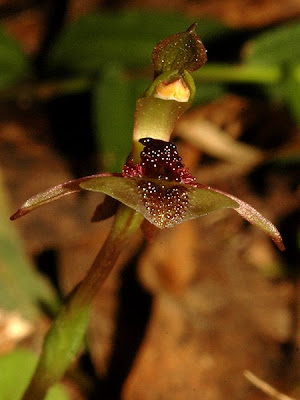Here are two shots of the side of the flower. It is a small Greenhood, growing to less than 6 inches (most were smaller than that).
 Mature flowers have a brownish tinge on the "nose" of the hood.
Mature flowers have a brownish tinge on the "nose" of the hood. The labellum has an interesting shape, resembling a mini surfboard, complete with a nice brown stripe down the middle. Very cute detailing.
The labellum has an interesting shape, resembling a mini surfboard, complete with a nice brown stripe down the middle. Very cute detailing. I also saw the first of the winter/spring flowering "Ant Orchids" - which these days are classed as members of the genus Myrmechila. The more common "Ant Orchids" or "Wasp Orchids" in this district are the autumn flowered species, which are classed as Chiloglottis. All of these related plants are still classed as members of the genus Chiloglottis in the minds of the people who run the PlantNET website at the RBG Sydney - even though there are very good reasons to class these plants as separate genera, especially the much larger-flowered Bird Orchids (now called Simpliglottis). Related plants, yes. Same genus - I don't think so. I go with Jones and Clements.
I also saw the first of the winter/spring flowering "Ant Orchids" - which these days are classed as members of the genus Myrmechila. The more common "Ant Orchids" or "Wasp Orchids" in this district are the autumn flowered species, which are classed as Chiloglottis. All of these related plants are still classed as members of the genus Chiloglottis in the minds of the people who run the PlantNET website at the RBG Sydney - even though there are very good reasons to class these plants as separate genera, especially the much larger-flowered Bird Orchids (now called Simpliglottis). Related plants, yes. Same genus - I don't think so. I go with Jones and Clements.This plant is Myrmechila (Chiloglottis) formicifera (the "Ant Orchid" - in English and Latin names).
From the front, the column is a clean green/yellow colour, whereas the basically similar Chiloglottis seminuda (an autumn flowerer) has strong lines of red across the flat front edge of the green "column". The "pseudo-insect" has a double-headed shape, by which I mean it is like a bug-eyed insect. You can make out clearly the protrusion at the far end of the "pseudo-insect's head". In fact it protrudes to the left and the right. Some of the autumn-flowered species have heart-shaped "glands". This one clearly is not like that.
The secondary set of glands, smaller little bobbles of "jelly" go right to the bottom of the labellum (that is the diamond-shaped blade which is protruding at the front of the flower). Also, the lateral sepals are held shallowly, and are widely divergent (like two narrow blades, on the left and right). They are reflecting the light from the flash, and so they stand out, in this image. That is a considerable difference from the autumn-flowered Chiloglottis species which I have photographed, where the lateral sepals are held very low under the labellum, either reflexed or bent forward under the labellum, but not spread wide, like in this flower.
 Here you may observe the gap between the major gland (the "pseudo-insect") and the smaller glands which extend all the way down to the tip of the diamond-shaped labellum. The "pseudo-insect" not only resembles an Ant (in our eyes), but apparently it emits scents which mimic the scents of female wasps, and so, it attracts male wasps which attempt to copulate with the flower. Thus does the flower achieve its pollination. This is called "pseudo-copulation". All of this is now well documented, and it is not my imagination running away with me.
Here you may observe the gap between the major gland (the "pseudo-insect") and the smaller glands which extend all the way down to the tip of the diamond-shaped labellum. The "pseudo-insect" not only resembles an Ant (in our eyes), but apparently it emits scents which mimic the scents of female wasps, and so, it attracts male wasps which attempt to copulate with the flower. Thus does the flower achieve its pollination. This is called "pseudo-copulation". All of this is now well documented, and it is not my imagination running away with me. I would have to say that I went looking in a place where I had previously been shown leaves of these Orchids, and found some leaves straight away. I stared and stared and it was only when I knelt down to get a really close look that I found the first flower. It was about 3 inches from my hand. What I am trying to say is these tiny, dark flowers are really hard to see, even when you know they are there - right in front of you.
I would have to say that I went looking in a place where I had previously been shown leaves of these Orchids, and found some leaves straight away. I stared and stared and it was only when I knelt down to get a really close look that I found the first flower. It was about 3 inches from my hand. What I am trying to say is these tiny, dark flowers are really hard to see, even when you know they are there - right in front of you.Because these small flowers are so well camouflaged, it is no surprise, therefore, that they are famous for their reliance upon scent glands in order to attract pollinators. In fact, it is an interesting area of science which brings together entomologists (who identify the insects), botanists and molecular biologists, who identify the chemicals which the plants use to attract the pollinating insects.

No comments:
Post a Comment